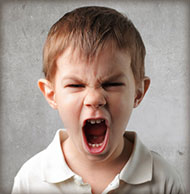 My son was mad. Steaming mad. Screaming mad.
My son was mad. Steaming mad. Screaming mad.
“I hate everything,” he roared. “It’s not fair!”
I could feel my own frustration rising. He had a point, but in my opinion he was overreacting. How could this child who was so capable of having rational conversation be suddenly so irrational?
We may find it unsettling when our children display extreme emotions and are seemingly out of control. Yet, we know it’s important for them to express feelings such as anger, particularly since the medical community tells us that suppressed anger can show up later as stress and depression. By learning to verbalize their feelings and take appropriate actions, we guide our children to feel empowered and strong.
The reality is that life isn’t always fair. Our children have to learn that they can’t always get what they want and not everyone can be number one at everything. But rather than slam my son with these harsh life lessons and advice to “suck it up,” I look at these incidents as opportunities to help him learn to express and manage anger productively.
Anger is a natural emotion. It can be powered by disappointment or frustration, or as a reaction to a situation that is perceived to be somehow unfair. The angry party typically feels disempowered, and disempowerment can feel kinda scary.
Anger is different from aggression. Anger is a feeling, while aggression plays out as an action. Often the feeling (frustration, disappointment, disempowerment) may lead to action – but it doesn’t have to.
That’s where we can help our kids understand the feeling and how to manage it. Anger can sometimes be motivating, empowering us to figure out what and how to change a situation. A simple example is a child who is angry at not being able to shoot a basketball into a hoop. If she channels that angry energy into practice, then she can develop better skills. Eventually, she will make a basket and feel a sense of accomplishment.
So anger isn’t bad; it’s just an emotion. Some ways your child can express his/her emotion include:
- Punch a pillow or other soft object.
- Throw stuffed animals at the wall or other appropriate target
- Let out a “primal” scream
- Be physical in positive ways, such as running, dancing or doing jumping jacks
- Count to 10 while taking deep breaths
- Walk away from a situation and take some “alone time” until she has settled down and can have a calm conversation
It’s helpful to set up rules around expressing anger, such as:
- Lashing out at others (or yourself) with physical behavior, such as punching, kicking, hair-pulling, is unacceptable.
- Name-calling and bullying words won’t be tolerated. Words hurt and can be difficult to take back.
When a child has calmed down, ask him to explain in words what made him angry. Ask him to describe the feeling in words. When a child can express a feeling with words, they are less likely to lash out physically.
Validate his feelings. “I understand you were angry about not being able to make that basket. It can be frustrating when we can’t do something we want to.” There is no reason for him to think his feelings are “bad.” We all get angry from time to time.
Talk about how he expressed his anger, and compliment him if he did so in a positive manner. “I am proud of you for working out your anger by punching a pillow.”
Help him make a plan. How can he use that anger in a positive manner? What change could he make to help him not feel angry about a similar situation? How could he handle a similar situation in the future?
By expressing anger in the safe environment of home, children learn to deal with feelings of frustration when they feel it at school or with friends. They understand how to verbalize a feeling and use the energy of it to make a positive change.
It’s important that our children see us manage our anger in a similar manner. Use words to describe a whole range of feeling, such as mad, sad, frustrated, glad, excited, etc. By explaining our actions, we model appropriate behavior for children. The results will leave us all feeling good.
ADDITIONAL RESOURCES:
- FamilyEducation.com offers tips for preschoolers in Helping Your Child Express Anger Appropriately
- StressFreeKids.com has 12 Ways to Help an Angry Child Manager Their Anger
- Learn ways to help toddlers, preschoolers and elementary-age children in CNN’s Teach Your Child to Handle Anger
- An interesting piece on the benefits of anger in The Upside of Anger: 6 Psychological Benefits of Getting Mad
Karen Nerney has been a communications specialist with Capital Region BOCES since 2011. She is mom to two daughters, 18 and 16, and a son, 10.
Copyright ©2015 by Parent Today and Capital Region BOCES; Used with permission
 Skip to Content
Skip to Content Capital Region BOCES
Capital Region BOCES


